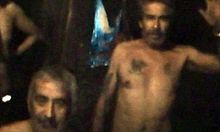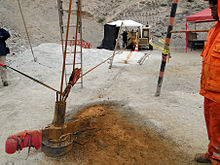- Miners' health issues during 2010 Copiapó mining accident
-
Main article: 2010 Copiapó mining accident
The 2010 Copiapó mining accident began as a cave-in on 5 August, 2010 at the San José copper-gold mine in the Atacama Desert near Copiapó, Chile. The accident left 33 men trapped 700 meters (2,300 ft) below ground who survived underground for a record 69 days.[1][2] All 33 men were rescued and brought to the surface on 13 October 2010 over a period of almost 24 hours. After the last trapped miner was winched to the surface, the rescue workers still underground held up a sign before the camera stating "Misión cumplida Chile" (English: "Mission accomplished Chile") to the estimated more than 1 billion people watching the rescue on live television around the world.[3]
The San José Mine is about 45 kilometers (28 mi) north of Copiapó, in northern Chile.[4] The miners were trapped approximately 5 kilometers (3 mi) from the mine entrance. The mine had a history of instability that had led to previous accidents, including one death.[5][6][7]
The retrieval of the first miner, Florencio Ávalos, began on Tuesday, 12 October at 23:55 CLDT, with the rescue capsule reaching the surface 16 minutes later.[8][9] Less than 24 hours later, at 21:55 CLDT on 13 October, all 33 miners had been rescued, almost all in good medical condition, and expected to recover fully. Two miners were suffering from silicosis, one of whom also had pneumonia, and others were suffering from dental infections and corneal problems.[10] Three of the rescued miners had immediate surgery under general anesthesia for dental problems.[11]
Health of the trapped miners
On 23 August, voice contact was made with the miners. They reported having few medical problems; the doctor in charge of the rescue operation told the media that "they have considerably less discomfort than we might have expected after spending 18 days inside the mine, at 700 meters (2,300 ft) deep and under high temperatures and high humidity". The doctors also reported that the miners had already been provided with a 5% glucose solution and a drug to prevent stomach ulcers resulting from food deprivation.[12] Material was sent down in 5-foot-long (1.5 m) blue plastic capsules nicknamed palomas ("doves", referring to the role of carrier pigeons), taking an hour to reach the miners.[13][14] Engineers coated the boreholes with a gel in order to ensure the integrity of the shafts and ease the passage of the capsules.[15] In addition to high-energy glucose gels, rehydration tablets, and medicine, rescuers also sent down oxygen after the miners reported there was not enough air.[14] Delivery of solid food began a few days later.[14][16] Two other boreholes were completed—one for oxygen enriched air, the second for videoconference equipment to allow daily video chats with family members.[16] Relatives were permitted to write letters, but were asked to keep them optimistic.[13]
Out of concern for the miners' morale, rescuers hesitated to tell them that according to the conservative plan, the rescue might take months, with an eventual extraction date close to Christmas. The miners who had been trapped since August would miss many events, including the Chilean Bicentennial celebrations and important soccer games, in addition to their personal anniversaries. The miners were fully informed, however, on 25 August, of the projected timeline for their rescue and the complexity of the plans to get them out. The mining minister reported that the men took the potentially negative news very well.[17]
Rescue workers and consultants described the miners as a very disciplined group.[18] Psychologists and doctors worked with the rescue effort to ensure the miners kept busy and mentally focused.[14] Fluorescent lights with timers were sent down to keep the men on a normal schedule by imitating day and night.[16] The miners affirmed their ability to participate in rescue efforts, saying "There are a large number of professionals who are going to help in the rescue efforts from down here."[19] Psychologists believed that the miners should have a role in their own destiny as it was important to maintain motivation and optimism.[19] They divided themselves into three eight-hour shifts with each shift responsible for handling the palomas, environmental safety, preventing further rock falls, communications and sanitation-related tasks.[19][20][21][22] Luis Urzúa became the overall leader and the oldest miner, Mario Gómez, was chosen to provide spiritual guidance.[19] Mental health experts supported the hierarchical structure to preserve order and routine within the group believing it to be crucial to their mental health.[23]
Doctors determined that Yonni Barrios was the most qualified of the miners to undertake medical tasks and to communicate on health issues, due to his previous medical training.[24] He made daily rounds, administering diagnostic tests, taking samples and updating patient charts, and participated in daily conference calls with the medical team above. He became so busy that he recruited Daniel Herrera to assist with the record-keeping.[25] Barrios vaccinated the group against tetanus, diphtheria, flu and pneumonia.[18] Many of the miners developed severe skin problems due to the hot and wet conditions.[18] They were sent quick-drying clothing and mats so they would not have to sleep directly on the ground.[18] In September, they received first aid kits, which included tourniquets, IV kits, and splints, and they received first aid training by videoconferencing.[26]
Sanitation was an important issue in their hot, humid environment, and the miners took steps to maintain hygiene throughout their confinement. "They know how to maintain their environment. They have a designated bathroom area, garbage area and are even recycling," said Dr Andrés Llarena, an anesthesiologist with the Chilean navy. "They put plastic stuff away from biological [wastes], in different holes. They are taking care of their place." The men used a natural waterfall for regular showers and received soap and shampoo from the palomas, while dirty laundry was sent out. They dug out several fresh water sources which doctors determined to be potable and were provided water purification tablets as well.[25]
Environmental and safety issues were also a primary concern. Jimmy Sánchez, the youngest of the group at 19, was assigned as the "environmental assistant", and tested the air quality daily with a hand-held computerized device that measured oxygen, carbon dioxide levels and air temperature that normally averaged 31 °C (88 °F). Teams of miners also patrolled their area to identify and prevent potential rockfalls and pry loose hazardous stones from the ceiling, while others worked to divert the streams of water from the drilling operations.[25]
Health Minister Jaime Mañalich stated, "The situation is very similar to the one experienced by astronauts who spend months on end in the space station."[27] On 31 August, a team from NASA in the United States arrived in Chile to provide assistance. The team included two physicians, one psychologist, and an engineer.[28]
After the rescue, Dr. Rodrigo Figueroa, chief of the Trauma Stress and Disaster unit of the Pontifical Catholic University of Chile, said there were serious shortcomings in the censorship of letters to and from their relatives above ground and in the monitoring of activities the miners could undertake, as being underground has suddenly turned them into “babies,” he said. But the natural strength of “The 33” managed to keep them alive, and their natural organization into teams as a response to disaster was also part of the human response to threat. And as the miners’ sound minds have seen them through, they will continue to be tested as they now resume life above ground.[29]
See also
- Quecreek Mine Rescue involved a similar rescue capsule in Pennsylvania, July 2002 to rescue a trapped mining crew.
- Dahlbusch Bomb
References
- ^ "Onemi confirma a 33 mineros atrapados en yacimiento en Atacama" (in Spanish). La Tercera. 6 August 2010. http://www.latercera.com/noticia/nacional/2010/08/680-282082-9-onemi-confirma-33-mineros-atrapados-tras-derrumbe-en-yacimiento-en-atacama.shtml. Retrieved 12 October 2010.
- ^ Illiano, Cesar (9 October 2010). "Rescue near for Chile miners trapped for 2 months". Reuters AlertNet. http://www.alertnet.org/thenews/newsdesk/N08212025.htm. Retrieved 11 October 2010.
- ^ Chilean mine rescue watched by millions online, Canadian Broadcasting Corp., 14 October 2010
- ^ Haroon Siddique (23 August 2010). "Chilean miners found alive – but rescue will take four months". London: The Guardian. http://www.guardian.co.uk/world/2010/aug/23/miners-trapped-alive-chile. Retrieved 23 August 2010.
- ^ "Trapped Chile miner's family sues owners and officials". BBC News. 26 August 2010. http://www.bbc.co.uk/news/world-latin-america-11102478. Retrieved 27 August 2010.
- ^ Govan, Fiona, Aislinn Laing and Nick Allen (26 August 2010). "Families of trapped Chilean miners to sue mining firm". London Daily Telegraph. http://www.telegraph.co.uk/news/worldnews/southamerica/chile/7966590/Families-of-trapped-Chilean-miners-to-sue-mining-firm.html. Retrieved 26 August 2010.
- ^ 69-day trapped Chilean miners being lifted one by one to safety, Asian Tribune, Hallstavik, Sweden, By Gopal Ethiraj, 14 October 2004
- ^ "First of 33 trapped miners reaches surface". CNN. 12 October 2010. http://news.blogs.cnn.com/2010/10/13/workers-begin-to-rescue-trapped-chilean-miners/?hpt=T1&iref=BN1. Retrieved 12 October 2010.
- ^ Hutchison, Peter; Malkin, Bonnie; Bloxham, Andy (12 October 2010). "Chile Miners Rescue: Live". London Daily Telegraph. http://www.telegraph.co.uk/news/worldnews/southamerica/chile/8058924/Chile-Miners-Rescue-Live.html. Retrieved 12 October 2010.
- ^ "Chile mine rescue". BBC News. 13 October 2010. http://www.bbc.co.uk/news/world-latin-america-11489439.
- ^ First Chile miners leave hospital - Australian Broadcasting Corporation (15 October 2010) - Retrieved 18 October 2010
- ^ "CMineros confirman que están en perfecto estado de salud tras contacto por citófono" (in Spanish). Radio BioBio. 23 August 2010. http://www.radiobiobio.cl/2010/08/23/mineros-confirman-que-estan-en-perfecto-estado-de-salud-tras-contacto-por-citofono/. Retrieved 23 August 2010.
- ^ a b "Trapped Chile miners receive food and water". BBC News. 23 August 2010. http://www.bbc.co.uk/news/world-latin-america-11064687. Retrieved 23 August 2010.
- ^ a b c d "Chile miners face four-month wait for rescue". Associated Press. MSNBC. 23 August 2010. Archived from the original on 24 August 2010. http://www.webcitation.org/5sEM67Dmo. Retrieved 24 August 2010.
- ^ Hough, Andrew and Damien McElroy (24 August 2010). "Trapped Chile miners survived 18 days underground on pieces of tuna and milk". London Daily Telegraph. http://www.telegraph.co.uk/news/worldnews/southamerica/chile/7961349/Trapped-Chile-miners-survived-18-days-underground-on-pieces-of-tuna-and-milk.html. Retrieved 27 August 2010.
- ^ a b c Franklin, Jonathan (27 August 2010). "NASA helping in historic rescue of trapped Chilean miners". The Washington Post. http://www.washingtonpost.com/wp-dyn/content/article/2010/08/27/AR2010082704867.html. Retrieved 27 August 2010.
- ^ "Chile's trapped miners told rescue could take months". BBC News. 25 August 2010. http://www.bbc.co.uk/news/world-latin-america-11092343. Retrieved 25 August 2010.
- ^ a b c d Prengaman, Peter (29 August 2010). "Chile miners must move tons of rocks in own rescue". Associated Press. http://www.google.com/hostednews/ap/article/ALeqM5i075ahoJZZkuwcSyRJcUkUDZKuFQD9HTERM80. Retrieved 29 August 2010.
- ^ a b c d Laing, Aislinn and Nick Allen (27 August 2010). "Chile miners give video tour of cave". London Daily Telegraph. http://www.telegraph.co.uk/news/worldnews/southamerica/chile/7968125/Chile-miners-give-video-tour-of-cave.html. Retrieved 27 August 2010.
- ^ Daily rigors of underground life to end for Chile miners, AsiaOne News, AFP with Gael Favennec, 11 October 2010
- ^ Martyn McLaughlin Trapped miners told: 'work 24 hour shifts and remove 4,000 tons of rock, The Scotsman, 31 August 2010
- ^ Fiona Govan Trapped miners form micro-society to keep them sane, London Daily Telegraph,3 September 2010
- ^ Victor Herrero To relieve miners' hell: Latrine, books, antidepressants?, USA Today, 26 August 2010
- ^ Franklin, Jonathan (26 August 2010). "Trapped Chilean miners face long shifts to keep their refuge clear of debris". London: The Guardian. http://www.guardian.co.uk/world/2010/aug/26/trapped-chilean-miners-clear-debris. Retrieved 27 August 2010.
- ^ a b c Jonathan Franklin Chilean miners: A typical day in the life of a subterranean miner, The Guardian, 9 September 2010
- ^ Hough, Andrew (9 September 2010). "Chilean miners' new medical 'survival kits' used by British troops". London Daily Telegraph. http://www.telegraph.co.uk/news/worldnews/southamerica/chile/7981437/Chilean-miners-new-medical-survival-kits-used-by-British-troops.html. Retrieved 9 September 2010.
- ^ "Get us out of underground 'hell,' Chile miners plead". Agence France-Presse. 25 August 2010. http://www.google.com/hostednews/afp/article/ALeqM5hHejkzmj_dWqXSObe-VR3LGdt9ag. Retrieved 25 August 2010.
- ^ "NASA Provides Assistance to Trapped Chilean Miners". NASA. 1 September 2010. http://www.nasa.gov/news/chile_assistance.html. Retrieved 2 September 2010.
- ^ Miners' Rescue In Chile: An Inspiring Note: We’re OK, All 33 (Special Report Excerpt)(English), The Santiago Times, Kara Frantzich and Ricardo Pommer
Categories:- History of Atacama Region
- Mining in Chile
- 2010 Copiapó mining accident
- Health
Wikimedia Foundation. 2010.



